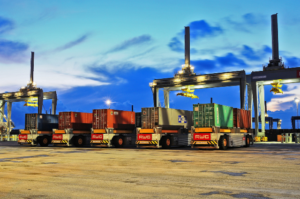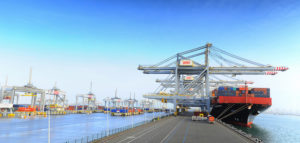
Rotterdam World Gateway (RWG) provides container storage and transshipment with maximum efficiency. Seamless access to Europe is what RWG stands for: seamless transit of containers from all over the world to consumers and businesses in Europe. And vice versa.
Based in the global leading port of Rotterdam, RWG heavily relies on its IT Infrastructure. To be as efficient as possible, all of the deep sea quay cranes, barge cranes and stacking cranes are fully automated and controlled remotely by specialists in the office building. For internal transportation RWG uses fully automated guided vehicles.
Reliable and sustainable IT
Paul Saraber, Supervisor IT Engineering team and IT Architect at RWG: ‘Our terminal is designed from ground zero with high efficiency as a starting point. From the start of the terminal build in the summer of 2012 up to the grand opening in September 2015 we have been building the IT Infrastructure alongside. We are operational 24/7 and when container vessels arrive or are about to depart, time pressure is high. We simply cannot afford to have any delays in handling container logistics. This means that our IT Infrastructure – hardware, software and services – must be very reliable.’
 Paul Saraber emphasizes that sustainability is one of the key values of RWG and this also counts for IT: ‘This means that we invest in our IT Infrastructure and staff, but do not want to overspend to meet our goals.’
Paul Saraber emphasizes that sustainability is one of the key values of RWG and this also counts for IT: ‘This means that we invest in our IT Infrastructure and staff, but do not want to overspend to meet our goals.’
Searching for insights
After the terminal was successfully opened and is now operating according to expectations, RWG’s IT team found the time to take a deep dive into ‘what they had built’. Paul Saraber: ‘Not that we didn’t know what we had built, but we had a lack of insights in especially our software usage. From start to actual operating status there were changes to the original design, all due to the fact that we innovated and improved during the build. In the end, we knew what we were actually using, but were not sure which software form the project ‘built’ phase still was, or was not in use. We wanted to get better insights and make sure we operate compliant with copyright law and software vendor agreements.’
RWG sent out a request for proposal to a selected group of software asset management consulting firms to select a partner to help them.
It is not a project
Peter van Uden, Managing Director and Senior SAM Consultant at Quexcel: ‘We were very pleased with Paul’s call that we turned out to be the partner of choice to help RWG. The big advantage of our Managed Software Asset Management Solution is the underlying SAMLive! platform which operates agentless. In that way, there is a zero impact on the IT Infrastructure which is very important for organizations that operate around the clock and have critical operational processes which heavily rely on software.’
 Paul Saraber completes: ‘True, and we were pleased that within only 48 hours after start of the inventory we had over 95% completeness of the hardware and software we use.’
Paul Saraber completes: ‘True, and we were pleased that within only 48 hours after start of the inventory we had over 95% completeness of the hardware and software we use.’
But Managed Services is more than making an inventory and looking at the results. Peter van Uden continuous: ‘Indeed. We are here to help and guide our customers. Based on the actual data we help customers optimize their IT environment. However, Software Asset Management is not only about technology but also about people and process, so we help with all aspects. At the technical side, the discovery of legacy applications, out of support software, vulnerabilities and many other aspects play an important role. By using the SAMLive! platform, we are able to help customers improve their IT security, make better use of resources and help them innovate alongside. It is a true partnership where customer and managed service provider work together.
Saving money
One of the benefits of Software Asset Management are the insights RWG has achieved. Paul Saraber: ‘Let’s take SQL Server as an example. We already knew how many SQL Servers we are using. We did know which editions, but we didn’t always know which versions or which SQL Server was covered by a license of one of our software vendors, or should be covered by us. This is a risk for incompliancy. But more important, by analyzing the data and with the licensing expertise of Quexcel, together we were able to make a business case around our SQL Server usage. In the end, it turned out that building a SQL Server cluster in active-active mode would provide us with the much needed reliability and availability, but would also help save us tenth of thousands of euros in SQL Server licensing. That is Managed Software Asset Management the way we like it.’
Peter van Uden: ‘This way of work counts for all Microsoft software, but also for other software vendors. We constantly monitor the environment, give warnings when critical situations appear and help customers improve their IT environment. Being able to help customers saving money while maintaining customers’ goals is a nice additional benefit.’
Continuous improvement
One of the characteristics of a managed service is the ongoing collaboration between customer and service provider. Both are continuously looking for improvement in technology, process and IT-human interaction. Only in this way customers like RWG are able to innovate in this era of digital transformation and keep way ahead of their competition. Paul Saraber concludes: ‘These days, Software Asset Management isn’t a onetime project. Our customers, our organization and our IT are constantly on the move. We are continuously looking for improvements and are glad we have a partner like Quexcel to help us.’
